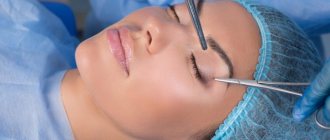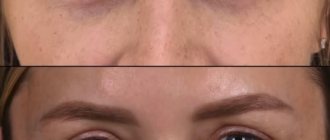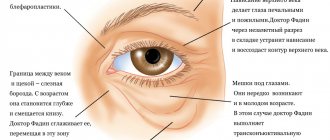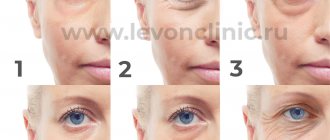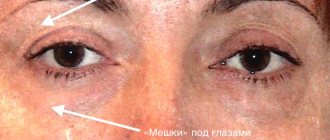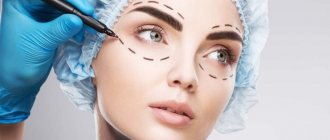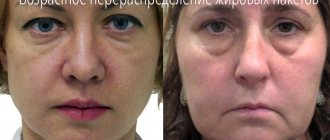Laser blepharoplasty is eyelid surgery using a laser, which allows patients of all ages to restore youth and beauty to the eye area.
In the photo: a patient before and after circular blepharoplasty of the upper and lower eyelids 1 week after surgery
The laser helps make blepharoplasty surgery less traumatic and virtually bloodless, because it cauterizes small vessels and minimizes the appearance of hematomas and swelling after surgery.
Laser eyelid blepharoplasty has become popular due to the high degree of patient satisfaction with the results of the operation compared to traditional surgery.
If you want to restore youth to your eyes , are tired of bags under your eyes, puffiness, wrinkles and drooping eyelids - sign up for a free consultation - this is how you will take the first step towards perfection.
Blepharoplasty of eyelids - before and after
In the photo: Blepharoplasty of the upper eyelids before and after
Circular blepharoplasty, The result is presented 1 week after surgery
In the photo: Blepharoplasty of the upper eyelids, 3/4 view
See more photos before and after eyelid blepharoplasty in the photo gallery
Circular blepharoplasty
During circumferential blepharoplasty, the lower and upper eyelids are corrected simultaneously. Incisions are made in the natural folds of the eyelids. Depending on the identified problems, the doctor removes excess fat, excises excess skin, and fixes tissue in new places. A circular tightening of the muscle tissue can be done.
Afterwards, stitches and a bandage are applied.
The operation lasts about 2 hours.
Who can benefit from blepharoplasty? Indications
Blepharoplasty may help if you have:
- Excess fat deposits on the upper or lower eyelid that cause puffiness
- Weak skin of the upper eyelid that hangs over the eyeball
- Bags and dark circles under the eyes
- Sagging and age-related changes in the lower eyelids
- Wrinkles in the paraorbital area
- The desire to change the shape and shape of the eyes, for example - Europeanization of Asian eyes
In the presence of severely drooping outer corners of the eyebrows, it is more effective to combine upper eyelid blepharoplasty with a forehead and eyebrow lift.
Laser blepharoplasty of the upper eyelids
Laser blepharoplasty is performed to reduce the amount of excess skin and fat in the upper eyelid area, thereby eliminating sagging and puffiness in this area.
The method has virtually no differences from the traditional one, with the exception of the use of a laser instead of a scalpel during the operation.
The surgeon makes an incision in the natural crease of the upper eyelid, then removes excess skin, muscle and fat, then closes the incisions with thin sutures that leave invisible scars.
Video of upper blepharoplasty surgery. Surgeon Zharkova S. N.
Laser blepharoplasty of the lower eyelids
Blepharoplasty of the lower eyelids is performed to correct and eliminate excess skin, wrinkles, bags and swelling under the eyes. It can rejuvenate your lower eyelids for a long time, restoring your beauty and self-confidence!
Lower eyelid blepharoplasty can be performed through an external incision or through an incision in the inner part of the eyelid (transconjunctival blepharoplasty). When using the “suture” method, the skin is incised along the natural line of the eyelid just below the eyelash line, which avoids conspicuous scars. The incision removes excess fat and excess skin that cause bags under the eyes.
Learn more about lower eyelid blepharoplasty
Transconjunctival (sutureless) blepharoplasty
The essence of the operation is that the surgical incision is located along the line of the conjunctiva, that is, on the inside of the lower eyelid. Hence the second name - “sutureless”, since sutures are not required after transconjunctival blepharoplasty: the dissected area located on the mucous membrane heals on its own.
In this regard, laser blepharoplasty is more profitable than traditional blepharoplasty - the surgeon removes excess fatty tissue through small punctures, which he makes with a laser beam. Under the influence of laser radiation, cellular processes are activated, provoking more intense tissue regeneration.
Accordingly, the rehabilitation period is significantly reduced: complete recovery occurs in three days, minor swelling and bruising disappear on their own within a week and a half.
In addition to all of the above, the laser is used by the surgeon to renew the skin of the lower eyelids, eliminate facial wrinkles and the first age wrinkles: after completing work on eliminating the hernia formation, the doctor performs laser resurfacing of the eyelids.
Laser transconjunctival blepharoplasty allows you to perform two operations in one operation: to eliminate a cosmetic defect in the form of fatty hernias and to tighten, make the skin of the lower eyelids more elastic and smooth.
It is recommended only for those patients who have not yet been diagnosed with age-related ptosis (tissue drooping) in the area under consideration, characterized by a significant amount of excess soft tissue.
To correct age-related aesthetic deficiencies in the periorbital area, more complex techniques are recommended that require large-scale surgical intervention using traditional surgical instruments.
You can learn more about transconjunctival blepharoplasty here
Progress of laser blepharoplasty surgery
The duration of the procedure is from 30 to 90 minutes (on average 45 minutes) and depends on the complexity and volume. Before performing the operation, I will select the appropriate technique to obtain the best results, taking into account your wishes, physiological characteristics and health status.
Step 1 - Anesthesia
Usually a combination of local anesthesia and light intravenous sedation is used, however, with a large volume of surgical intervention, the choice may fall towards general anesthesia. In our clinic, pain relief is always carried out under the guidance of one of the best anesthesiologists in the country, which guarantees your safety and the absolute safety of your health.
Step 2 - Cuts
The incision lines depend on the type of plastic surgery performed and are always located in the natural folds of the skin, which makes the seams and scars completely invisible to the prying eye!
Step 3 - Closing the Cuts
Sutures are usually closed:
- Removable or absorbable threads
- Leather glue
- Surgical tape
- When performing “seamless” laser transconjunctival plastic surgery, no sutures are required.
In the video: a 54-year-old patient diagnosed with hernias and excess skin of the upper and lower eyelids. Atony of the lower eyelids. In addition, the patient has a scleral gaze and a negative vector. In general, the conditions for blepharoplasty “cannot be worse.” Severe excess skin, hernias of the upper and lower eyelids are also visualized. The planned operation includes: circumferential blepharoplasty with myopexy and canthopexy in the lower eyelid area. This volume of surgery will minimize the risk of postoperative complications. A prerequisite for successful rehabilitation in such situations is anti-scar physiotherapy. As a rule, this is ultraphonophoresis with longidase.
Laser (transconjunctival) blepharoplasty
There is also a method of transconjunctival blepharoplasty (laser blepharoplasty), the use of which is indicated in cases where there is no need to excise excess skin tissue, but only need to remove fatty hernias. The advantage of this method is the absence of scars, because hernias are removed through small punctures in the mucosa, which are carried out using a laser.
| Laser blepharoplasty is always lower eyelid surgery; in addition, it should be noted that not all patients are candidates for laser blepharoplasty, and this is taken into account during the preliminary consultation. |
I often combine blepharoplasty with other anti-aging surgeries, such as a facelift or forehead lift. This allows the patient to avoid two operations using general anesthesia, and also shortens the rehabilitation period.
After the operation, the patient needs to stay in the hospital for a couple of days, then he can return home. Laser blepharoplasty has a shorter recovery period. During the recovery period, I recommend that my patients sleep on the highest possible pillows to prevent fluid accumulation in the surgical area. For some time, regular treatment of the eyelids will be necessary to avoid the appearance of crusts, as well as the use of special ointments and drops.
Benefits of laser blepharoplasty
The laser blepharoplasty procedure is performed using a CO2 laser, which has a number of obvious advantages compared to a scalpel:
Its beam is transparent, which allows the surgeon to fully see the operated area (unlike traditional blepharoplasty, when the surgeon partially covers the operated area with a scalpel).- It cuts the tissue layer by layer (the depth of each cut is 2-3 mm), which significantly reduces the risk of damage to the eyeball, cornea and eyelashes.
- It has pronounced coagulating properties: the radiation “seals” small blood vessels at the incision sites, minimizing bleeding of the operated area. This not only reduces the recovery period, eliminating swelling and bruising, but also helps the surgeon during the operation. The absence of blood allows him to clearly see the operated area, which makes laser blepharoplasty safer and faster than traditional blepharoplasty.
- Under the influence of laser radiation, cellular processes are activated, provoking more intense tissue regeneration, which reduces rehabilitation time by almost 2 times
- If there are fine wrinkles in the lower eyelid area, the procedure may be accompanied by laser resurfacing. The combination of these procedures makes it possible to achieve comprehensive rejuvenation of the lower eyelid area, which is not achievable with traditional intervention. Laser eyelid resurfacing is a technology of the future that is in service at our clinic.
Despite the obvious advantages, there are opponents of this method of eye rejuvenation. Basically, they appeal to the fact that the scalpel allows you to make a more even cut.
As a rule, I combine different techniques and I must note that despite the fact that the recovery period after laser blepharoplasty is shorter, the result of the operation, no matter how it is performed, will be the same.
Eyelid surgery can be performed either in combination with other anti-aging procedures (for example, facelift) or independently.
Rehabilitation after eyelid surgery
After eyelid surgery under local anesthesia, you can go home almost immediately; if you use general anesthesia, you can go home the next day.
Primary recovery takes 7-14 days.
Stitches (if any) are removed on days 4-7. It depends on the amount of work done, the type of seam and your skin type.
- It is advisable to periodically apply cold compresses to the operated surface. Scars are noticeable at first, but become almost invisible after three weeks.
- Bruising and swelling depend on the individual characteristics of the body. They can last up to 2 weeks. The bruises disappear within a week. Redness in the eyeball due to a burst vessel goes away within 2 weeks.
- You can apply makeup after 10 days
- Most patients return to work within 7-10 days
- Some patients experience tearfulness or, conversely, dry eye syndrome. This can last several weeks - extremely rarely more than three months. Using eye drops significantly shortens the recovery period.
In the video: the patient immediately after surgery. In this form, the patient usually leaves the hospital for further outpatient observation.
The result of blepharoplasty after rehabilitation
In the photo: Patient before and after blepharoplasty of the upper and lower eyelids
Transconjunctival blepharoplasty – surgery without incisions
13.07.2015
The eyelids are the first to suffer
Our eyes themselves can retain youthful shine and vibrancy for many years. The eyelids give them telltale signs of aging. The fact is that their very thin skin is extremely susceptible to the influence of the external environment and quickly loses its firmness and elasticity, so it is in this area of the face that the first rays of wrinkles appear.
Such a fairly common type of plastic surgery today as blepharoplasty will help to effectively correct the “traces of time” on the upper and lower eyelids, remove bags under the eyes, and smooth out wrinkles. And transconjunctival blepharoplasty, in addition, allows you to do without incisions and postoperative scars.
Puncture instead of cut
The main distinctive feature of this type of correction can be judged by its very name: a small incision, or rather even a puncture, is made not outside the eyelid, but inside the conjunctiva - a thin transparent mucous membrane covering the outer surface of the eye and the inner surface of the eyelid. Which, by the way, heals much faster than the skin after the intervention. This is a seamless surgical intervention, which means that not only no scars are left, but no traces at all.
This operation is quite compatible with upper eyelid surgery, but is performed only on the lower eyelid. But, let’s make a reservation right away, it is not shown to everyone. If the aging process has reached a certain stage, and, as they say, “on the face” there are already clearly pronounced excesses of stretched, elastic skin of the eyelids, deep wrinkles, traditional blepharoplasty, which can easily cope with the correction of such defects, may still be preferable.
On the other hand, it is precisely timely transconjunctival blepharoplasty that can save a person from the need for a more traumatic operation for many years. In any case, when choosing a rejuvenation technique, the final word remains with the doctor.
In addition, you should definitely consult with an ophthalmologist: abnormalities such as inflammation of the conjunctiva, lacrimal glands and ducts, and some other eye diseases can serve as an obstacle to eyelid surgery.
Other contraindications include:
- diabetes,
- oncological and infectious diseases,
- problems with blood clotting,
- thyroid disease,
- in women - the menstrual period.
Fast, painless and without traces
Depending on the scale of the surgical intervention, the eyelid correction procedure using the transconjunctival blepharoplasty method can last from 30-40 minutes to an hour, rarely more. Local anesthesia is used in this case. Using the finest instruments, the surgeon removes excess fatty tissue through a puncture in the conjunctiva. With this procedure, bags and puffiness under the eyes are very effectively removed.
What is important is that this type of correction not only eliminates the appearance of postoperative scars, but also completely preserves the shape and shape of the eyes and does not interfere with facial expressions.
Before and after the procedure: doctor’s recommendations
Despite the relatively low level of complexity of the operation, its success largely depends on how clearly the patient follows the doctor’s recommendations. It is better to start preparing for the procedure in advance, about a month in advance: limit yourself to drinking alcohol and smoking, it is advisable to avoid taking blood thinning medications during this time. Women should time the day of surgery to avoid menstruation.
Recommendations for the recovery period are, in general, simple, but they must be followed. Cold compresses should be applied for some time to reduce swelling. Of course, abstaining from using cosmetics will only be beneficial. Your doctor may advise you to use special plasters to help the bruising and swelling go away faster.
If you lead an active lifestyle, you should limit yourself to sports for some time. In general, try to avoid heavy physical activity during the rehabilitation period. Don't overload your eyes with reading. You should stop using contact lenses for about a month. And the eyes should be protected from exposure to ultraviolet radiation for about three months after surgery - ordinary sunglasses are quite suitable for this.
In principle, patients usually return to normal life almost immediately after the procedure. For some time, there may be a burning sensation in the eyes and tearfulness. For more serious signs of discomfort, it is better to consult a doctor without delay.
Price is also important
So, let's summarize. The main advantages of this type of eyelid correction, transconjunctival blepharoplasty, include:
- its extremely low level of trauma,
- the most natural shape and shape of the eyes after the procedure,
- complete absence of seams and scars,
- minimal risk of side effects and complications,
- very short rehabilitation period.
And, which is also important, such an operation is much cheaper than many other types of rejuvenation.
Back to list
Link copied successfully
Blepharoplasty: stitches and scars after surgery
Regardless of the type of blepharoplasty chosen, the incisions are made in natural folds, due to which, after healing, the seams become almost invisible.
The method of classic upper eyelid surgery involves excision of overhanging skin in such a way that after healing the suture is hidden in the new fold of the eyelid. The incision is precisely measured down to millimeters, thanks to which the patient after the operation receives an open and youthful look without visible scars.- When performing lower blepharoplasty, the incision is made under the eyelash edge, also in a natural fold, in order to hide the plastic surgery performed after healing.
- The transconjunctival blepharoplasty method does not leave any visible scars after surgery. The essence of the operation is to make an incision on the inside of the eyelid.
Each specific type of eyelid surgery helps to get rid of sagging skin, remove folds, wrinkles or fat bags, but, nevertheless, this operation is considered the least traumatic and fastest to heal.
If you choose a competent specialist and perform a high-quality operation, the stitches will be invisible even upon close examination.
Visible scars after healing are a sign of poor quality work by a plastic surgeon or non-compliance with recommendations by the patient, except in isolated cases.
Circular blepharoplasty photo
In the photo: a patient after circular blepharoplasty
Memo to the patient after blepharoplasty
What you need to know and follow after blepharoplasty to achieve an excellent result:
- It is necessary to sleep on your back or side with your head elevated
- Minor postoperative pain may occur, which can be easily relieved with regular painkillers. If you experience significant pain, you should notify your surgeon immediately.
- Cold compresses should be applied for 15 to 30 minutes at least 6 times a day
- Important! Do not take aspirin or medications containing aspirin. For the upper eyelid, apply a special ointment 3 times a day. The doctor will give recommendations.
- For the lower eyelids, use eye drops (usually 1 drop 4 times a day)
- Do not use mascara, eyeliner, or eye shadow until cleared by your doctor (usually 10 to 14 days). Minimal makeup can be applied to areas of bruising on the lower eyelid, but is not acceptable for the upper eyelid, much less incision areas.
- Strenuous exercise and sports should be avoided for at least 3 weeks
- Avoid high temperatures (saunas or steam baths), as well as exposure to ultraviolet radiation (solarium or tanning) for a month
- When performing transconjunctival lower eyelid surgery, it is necessary to use sunscreen for a month after surgery.
Your questions
How long will the effect of the operation last? It depends on the patient himself. After all, the skin sags and loses tone not only due to age and genetic characteristics. Lifestyle is also of great importance: night work, lack of sleep, chronic fatigue do not have the best effect on the quality of the skin. Taking care of yourself is the main secret of youth and beauty.
Is there a best time of year to have blepharoplasty? The myth about the time of year came quite recently and is not substantiated by anything. The time of year does not affect the operation itself, the rehabilitation period, or the final result.
Which method do you use for transconjunctival blepharoplasty: redistribution or removal of hernias? During transconjunctival plastic surgery of the lower eyelids, I partially remove fatty hernias and partially redistribute them. Everything is very individual and depends on the specific situation.
Contraindications
The main contraindications are the same for any surgical intervention. This:
- any acute illness
- acute and chronic diseases of the eyes, lacrimal glands and ducts
- blepharospasm
- conjunctivitis
- bleeding disorder
- blood diseases
- chronic disease in the acute stage
- diabetes
- venereal diseases
You can find out the full list of contraindications during a free consultation.
Prices for blepharoplasty in Moscow
The cost of blepharoplasty depends on the complexity, the chosen method, the qualifications of the plastic surgeon, the level of service in the clinic, anesthesia and consumables. As a rule, everything is included in the price, except for tests, which you can pre-take either in the clinic itself or in any place convenient for you. Blepharoplasty is one of the most affordable anti-aging facial surgeries in Moscow.
In our clinic, the cost of blepharoplasty starts from 60,000 rubles. In your specific case, it will be possible to announce the price of blepharoplasty only after examination during a face-to-face consultation.
The consultation is free , sign up by calling +7 and 7 (495) 225-95-41 or using the feedback form in the site header.
At what age is it better to do it?
If you are concerned about such tissue sagging, it makes sense to think about surgery at an early stage, when the body’s reserve and recovery capabilities are still quite large. However, older patients who have retained sufficiently elastic skin around the eyes can also count on minimally invasive intervention.
How to determine if this method of facial rejuvenation is right for you, where to start?
It's simple. Consult a good plastic surgeon.
Ask a Question

